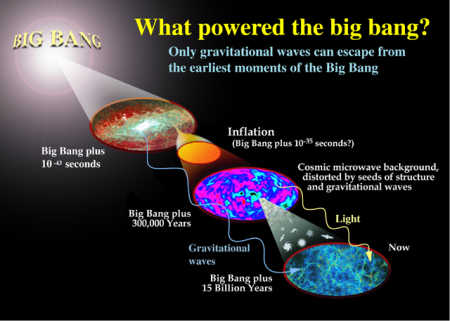|
|
Taxpayers Duped by Einstein - LIGO still peddling LIES*
(*Ludicrous, Insane Excuses for Spending)
by Dave Smith
|
|
August 22, 2009
|
|
|
|
Since Albert Einstein predicted the existence of gravitational waves
in 1916 with his general theory of relativity, scientists have been
devising ways of detecting them, but without any success despite throwing
huge buckets of money into the search.
|
|
|

Theory "predicting" gravitational waves
Credit: NASA
[Click to enlarge]
|
|
|
Scientists working with data from
the Laser Interferometry Gravitational-Wave Observatory (LIGO) and the
Virgo Collaboration, have again hailed the non-detection of gravitational
waves as a success, when the project has in reality been a dismal failure.
Yet we keep funding them...
A recent
news item from the University of Florida tells the story...
Gravitational Wave Observatory listens for echoes of universe’s birth
Wednesday, August 19, 2009
GAINESVILLE, Fla. — An investigation by a major scientific group headed
by a University of Florida professor has advanced understanding of the
early evolution of the universe.
An analysis of data from the Laser Interferometer Gravitational-Wave
Observatory Scientific Collaboration, or LIGO, and the Virgo Collaboration
has set the most stringent limits yet on the amount of gravitational waves
that could have come from the Big Bang in the gravitational wave frequency
band where LIGO can observe. In doing so, scientists have put new constraints
on the details of how the universe looked in its earliest moments.
“Gravitational waves are the only way to directly probe the universe
at the moment of its birth; they’re absolutely unique in that regard,”
said David Reitze, a UF professor of physics and the spokesperson for the
LIGO Scientific Collaboration. “We simply can’t get this information
from any other type of astronomy. This is what makes this result in particular,
and gravitational-wave astronomy in general, so exciting.”
The research is set to appear in the Aug. 20 issue of the journal
Nature. Seventeen UF faculty members, postdoctoral associates and
graduate students join the paper’s authors.
One could be forgiven for thinking that they've found something
positive, perhaps even important with this research. It certainly
sounds impressive. These four paragraphs are followed by another
six with essentially the same kind of advertising, all about how
important gravitational waves are and how good it is that we've
learned so much from the search so far. THEN, in the 11th paragraph,
we are finally given the truth of the matter, which is none-the-less
still followed by even more hubris.
The authors of the new paper report that the stochastic background of
gravitational waves has not yet been discovered. But the nondiscovery
of the background described in the Nature paper already offers
its own brand of insight into the universe's earliest history.
[emphasis added]
[...]
“Since we have not observed the stochastic background, some of
these early-universe models that predict a relatively large stochastic
background have been ruled out,” said Vuk Mandic, assistant professor
at the University of Minnesota and the head of the group that performed
the analysis. “We now know a bit more about parameters that describe
the evolution of the universe when it was less than one minute old.”
Now to be perfectly fair, they have actually come up with some useful
results. The terminology of "puts constraints on" is spin-speak
for "rules out lots of" the existing models. That's right, if a
non-detection has put constraints on a model, what they're saying is that
for everything they've searched for so far, the models have proved incorrect.
Or in all the frequencies they've searched and with the best sensitivities
available, they've found nothing, thus "narrowing down" the search
parameters.
But what's unsettling about all this is that they've not found any
gravitational waves in any of the science runs so far, and are now
searching the "noise" - that's right, it's the equivalent
of looking at a maltuned TV screen (before digital) and proclaiming
that amongst the "black and white ants" on the screen, one
can discern an image of a white cat in a snowstorm with its eyes closed...
Let me be quite clear about this. The only "positive" of
a null result in an experiment is having ruled out the theory which
led to performing the experiment. Once one starts staring at the
"noise" one is only constrained by the limits of one's
imagination... to say it puts constraints on several models might
aid in job security or tenure, but it doesn't assist in confirming
anything about the real world, except that their theories of gravitational
waves have so far been shown to be incorrect.
One would think that once a null result is obtained time and again,
then perhaps our time and money would be better spent doing something
else. And in this case, LIGO (and friends) has repeatedly failed to
turn up any positive results, yet at least three times now a
"non-detection" is lauded as successful!
Back in
January 2008 I wrote about LIGO lauding a
non-detection as a success, where from the source material came
this gem:
... LIGO is now producing scientific results. The nondetection
of a signal from GRB070201 ...
[emphasis added]
Then in
June of 2008 I had cause to write again, this
time they proclaimed that the Crab Pulsar had been "probed"
and we had looked into the core of a neutron star. However, the truth
was buried further down the release:
They compared the LIGO data with published data about the pulsar's
rotation rate from the Jodrell Bank Observatory, looking for a
synchronous gravitational-wave signal.
The analysis revealed no signs of gravitational waves ...
[emphasis added]
And now we have this:
... the stochastic background of gravitational waves has not
yet been discovered. But the nondiscovery of
the background described in the Nature paper already offers
its own brand of insight ...
[emphasis added]
Does anyone else recognize a pattern here? Every time they've done some
kind of analysis of the data LIGO has produced, they've come up empty-handed.
First, they looked at data which should have revealed gravitational waves
from GRB070201 - bzzzzzzt. Then they looked at data which should have
revealed gravitational waves from the neutron star at the heart of the
Crab Nebula - bzzzzzzt. Now, not having found any actual waves, they're
looking for the "stochastic background" thereof and guess what? - bzzzzzzt.
I've said it before and I'll say it again. Taxpayers, from ALL countries
involved in this spendfest, should be jumping up and down, shouting from
the rooftops that their money is being squandered and demanding more
control over how such money is spent.
Instead of going back to the drawing board, LIGO is looking forward to
2014 when it will be able to look "10 times further" into the
universe with their device. To my way of thinking, 10 times zero is
still zero, and the money would be better spent on something useful.
More on Einstein's Elusive Gravitational Waves in a
previous thunderblog by Stephen J. Crothers.
Dave Smith.
|
|
|
Permalink to this article.
Public comment may be made on this article on the
Thunderbolts Forum/Thunderblogs (free membership required).
For a comprehensive central repository of links to study
Plasma Cosmology/Electric Universe please visit:
PlasmaResources.com
|
|
|
|
|
|
|





